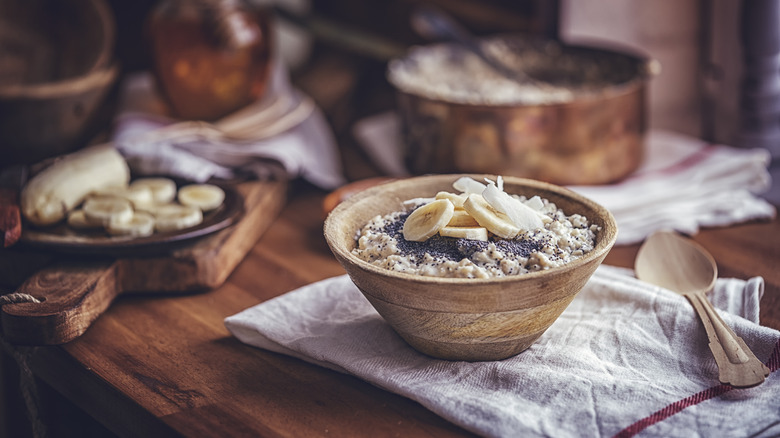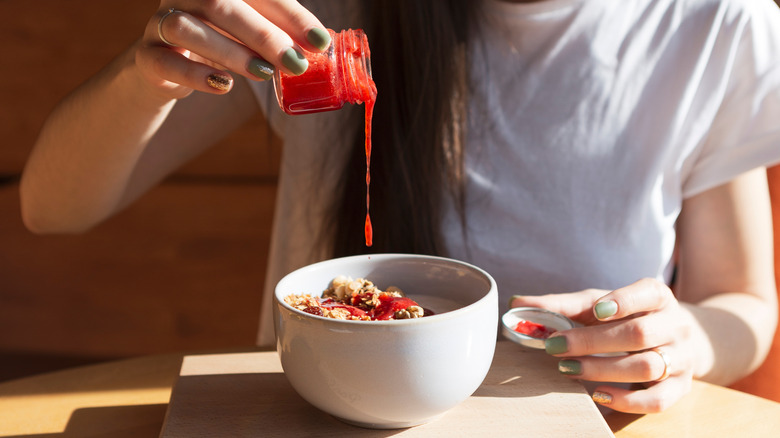Yes, It Matters Which Bowl You Use To Eat Oatmeal
Few meals are at once as comforting, filling, hearty, nutritious, and universally beloved as a simple bowl of oatmeal. From a baby's first meal to an afternoon snack or a stick-to-your-ribs breakfast, oatmeal is appealing to a wide variety of ages, palates, and purposes. And as simple as it may seem to combine a form of oat, a liquid, and heat, there's more that goes into making the perfect bowl of oatmeal. Next time, before you simply dump a scoop of oats into any old bowl and nuke it in the microwave (a perfectly respectable method for cooking in a rush!) consider the bowl you're using. Yes: There's a right and wrong type of bowl to use.
It all has to do with surface area and cooling times. While in many culinary cases, you may want your food to be able to cool off relatively quickly — such as a bowl of too-hot soup or a mug of scorching cocoa — nobody wants a gummy bowl of congealed oats. And if you've ever walked away from your breakfast and forgotten about your oatmeal, you know how gluey a bowl can get. For your next breakfast, use a deep bowl or even a coffee mug to store your hot cereal. This keeps it warm and creamy, not gloopy, for longer.
A deeper bowl with a smaller surface area is key to keeping oatmeal hot
Oatmeal can get a bad rap for being bland, gummy, or mushy. That first complaint can be fixed with proper adds-ins — think plenty of cinnamon, a pinch of salt, some brown sugar, or a swirl of jelly. As for a gummy or mushy consistency, the oatmeal's texture is heavily influenced by the bowl you use. When you ladle cooked oats from a pot into a shallow bowl, the oats will cool off much quicker than if spooned into a deeper soup bowl or mug. This is because according to the University of Minnesota, if you're using a shallow dish such as a pasta bowl, or any bowl with a depth of less than 2 inches, the heat contained in your cooked oats can travel and dissipate much faster than it would in a deeper container.
If you've ever had too-hot food that you've tried to cool off faster, you might have attempted spreading it out across a greater surface area. But to stop oatmeal from turning gluey before you can eat it, you want to employ the opposite tactic to keep it warm as long as possible. As cooling of food or any substance occurs, a large surface area for the transfer of heat speeds up the process, so keep those oats in a deep bowl instead.
Why does the texture of cold oatmeal turn so unappealing?
For those who love oats any time of the day, any way, you also know the right cooking methods and ingredients to give your bowl the perfect creamy consistency. Using instant oats versus rolled oats versus a steel cut oat recipe, as well as adjusting the liquid-to-oat ratio you use, can dramatically alter the final consistency.
Most of us can agree though that leftover oats or a bowl that's gone cold will take on a less than enjoyable consistency somewhat akin to glue. Why exactly does this happen? It's all to do with the soluble fiber in oats, which releases and helps the porridge stick together — but can also create a texture that makes oatmeal haters out of people who have never had a properly prepared bowl. Oatmeal is highly starchy. According to BBC Science Focus, each oat is about 60% starch, and as it cooks it also swells, absorbs water, and becomes thick. When oatmeal turns cold, this starch content shapeshifts, letting go of the liquid and becoming hardened and chewier.
Using the right bowl is key. As is the simple fix: Simply eating your oats before they have a chance to sit out for too long. Add a dollop of brown sugar, a handful of raisins, maybe some peanut butter, or whatever your favorite toppings, and odds are that they'll be enjoyed long before they have a chance to cool.


